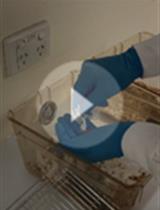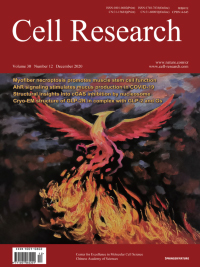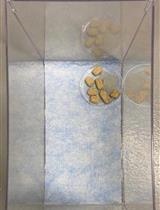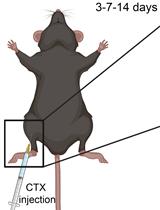- EN - English
- CN - 中文
Induction of Skeletal Muscle Injury by Intramuscular Injection of Cardiotoxin in Mouse
小鼠肌内注射心脏毒素诱发骨骼肌损伤的研究
发布: 2023年05月05日第13卷第9期 DOI: 10.21769/BioProtoc.4668 浏览次数: 3107
评审: Nafisa M. JadavjiSuresh KumarSabine Le Saux

相关实验方案

新生儿心肺疾病的小鼠双击模型:支气管肺发育不良(BPD)和与BPD相关的肺动脉高压
Steven P. Garrick [...] Claudia A. Nold-Petry
2022年11月05日 4161 阅读
Abstract
Skeletal muscle is the most abundant tissue in the human body and has a tremendous capability to regenerate in response to muscle injuries and diseases. Induction of acute muscle injury is a common method to study muscle regeneration in vivo. Cardiotoxin (CTX) belongs to the family of snake venom toxins and is one of the most common reagents to induce muscle injury. Intramuscular injection of CTX causes overwhelming muscle contraction and lysis of myofibers. The induced acute muscle injury triggers muscle regeneration, allowing in-depth studies on muscle regeneration. This protocol describes a detailed procedure of intramuscular injection of CTX to induce acute muscle injury that could be also applied in other mammalian models.
Keywords: Cardiotoxin (心脏毒素)Background
Skeletal muscle regeneration is a series of highly regulated processes mainly executed by muscle stem cells (MuSCs) (Hawke and Garry, 2001), including necrosis of damaged myofibers, immune cell infiltration, clearance of the damaged myofibers, MuSC activation and proliferation, myofiber formation and maturation, and muscle reconstruction. MuSCs, also named satellite cells, were first discovered by Dr. Alexander Mauro in 1961 (Mauro 1961). In response to muscle injuries, the quiescent MuSCs are activated to enter the cell cycle, proliferate, and differentiate into new myofibers or fuse to the injured myofibers to repair muscle injury. After activation and proliferation, part of the MuSCs will return to quiescence and replenish the in vivo stem cell pool (Bischoff, 1975; Konigsberg et al., 1975; Fu et al., 2015 and 2022).
Induction of acute muscle injury is a critical step to study muscle regeneration in vivo. Several methods have been applied to induce consistent acute muscle injury, including freezing, barium chloride injection, glycerol injection, notexin injection, and cardiotoxin (CTX) injection (Mahdy et al., 2015; Hardy et al., 2016). Among the reagents to induce acute muscle injury, CTX is the most commonly used. CTX disrupts the membrane integrity of neuronal and skeletal muscle and cardiac muscle cells (Dufton and Hider 1988); it has been speculated to form pores on the cell membrane that result in membrane depolarization and influx of Ca2+, causing overwhelming muscle contraction, myofiber lysis, and acute muscle injury (Harvey et al., 1982). This protocol describes the step-by-step procedure to induce skeletal muscle injury via intramuscular injection of CTX. Following CTX injection, mice can be sacrificed at different time points for further analysis, according to variable experimental requirements.
Materials and Reagents
1 mL syringe (for intraperitoneal injection), needle 0.45 mm (Shanghai Kindly Group, 2012-3151233)
0.5 mL insulin syringe with 29 G ½ needle (for cardiotoxin injection) (EXELINT, catalog number: 26028)
0.2 µm filter membrane (Millipore, catalog number: SLGPR33RB)
Cardiotoxin (CTX) 5 mg, from Naja atra (BOYAO BioTechnology, catalog number: 9012-91-3)
Phosphate-buffered saline (PBS) (Thermo Fisher, catalog number:10010023)
2,2,2-Tribromoethanol (TBE) (Sigma, catalog number: T48402)
Tert-amyl alcohol (Sigma, catalog number: 240486)
75% ethanol in liquid or in the form of pads (if using 95% or 99% ethanol, dilute with distilled water)
Equipment
Surgical scissors
Heating pad (Optional)
Procedure
文章信息
版权信息
© 2023 The Author(s); This is an open access article under the CC BY-NC license (https://creativecommons.org/licenses/by-nc/4.0/).
如何引用
Readers should cite both the Bio-protocol article and the original research article where this protocol was used:
- Fu, X., Li, S., Jia, M., Yang, W. and Hu, P. (2023). Induction of Skeletal Muscle Injury by Intramuscular Injection of Cardiotoxin in Mouse. Bio-protocol 13(9): e4668. DOI: 10.21769/BioProtoc.4668.
- Zhou, S., Zhang, W., Cai, G., Ding, Y., Wei, C., Li, S., Yang, Y., Qin, J., Liu, D., Zhang, H., et al. (2020). Myofiber necroptosis promotes muscle stem cell proliferation via releasing Tenascin-C during regeneration. Cell Res 30(12): 1063-1077.
分类
细胞生物学 > 组织分析 > 损伤模型
发育生物学
您对这篇实验方法有问题吗?
在此处发布您的问题,我们将邀请本文作者来回答。同时,我们会将您的问题发布到Bio-protocol Exchange,以便寻求社区成员的帮助。
提问指南
+ 问题描述
写下详细的问题描述,包括所有有助于他人回答您问题的信息(例如实验过程、条件和相关图像等)。
Share
Bluesky
X
Copy link










